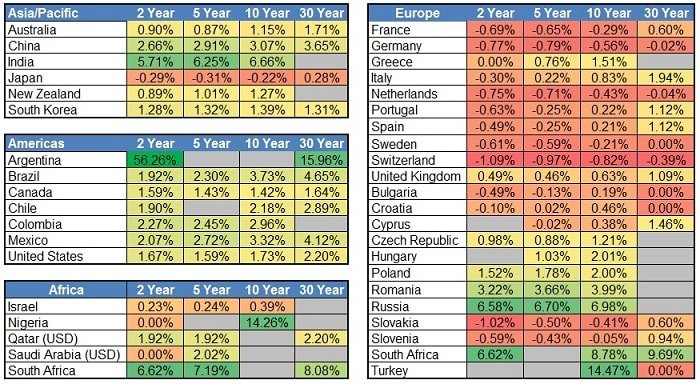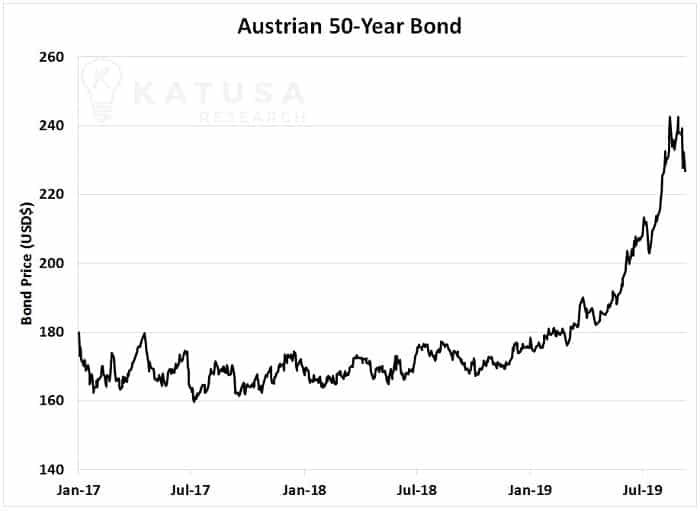
I came up with Financially Transmitted Disease, or FTDTM for short, a couple of years ago.
It all happened when I was having dinner with some colleagues discussing quantitative easing (QE) and negative interest rate policy (NIRP).
NIRP will have the biggest impact on our global markets moving forward.
I believe this is a monetary policy stance that major central banks like the European Central Bank, most global Central banks in emerging markets and even the People’s Bank of China are going to take.
This form of monetary policy is going to fuel a bonanza of ultra-cheap money. Just take a fresh look at the countries that have negative rates in the table below…

I rarely rant about economic policy, but NIRP has massive implications to the resource world that I want to position our portfolio for.
Almost all economists and market pundits believe NIRP will be a short-lived phenomenon. However, I have a very different take.
Negative interest rate policy changes the law of economics.
I also believe that NIRP will not only go much lower than almost everyone expects but will be with us globally. Across the board. For much longer than we can imagine.
First, let me explain why NIRP will go lower and stick around for a much longer time than anyone expects.
The general perception of NIRP, using a bond at a -0.5% interest rate, for example, means that if I buy that bond, I will get back less money in the future.
But, the reason why it’s working is the unit cost of the bond is rising significantly. This means the investor who is getting a negative interest rate, is making up for it on the bond price of the unit.
Examples of Financially Transmitted Diseases
The bond market is
many times the size of the stock market.
The price of Austria’s 50-year bond has gone up 28% year-to-date and 8.8%% in August alone. All the while the yield is -0.02% after taxes. That is an incredible return for the bond market unit.

From the perspective of a bond manager, he is aware he is taking the loss on the yield. But, he’s making a 28% gain on the unit price.
- This makes for a score rarely ever seen in the bond market.
The “sellers’ of these bonds are aware that the bond managers made 28% YTD on a -0.02% yield. So, they will do what the market always does and push the boundaries of logic.
It’s just a matter of time before a bond is -1%.
And then the gain won’t be 28% on the unit, but 15% (or whatever the market interprets). And the yield will continue lower as bond managers now chase gains, not yield.
- Bonds will soon be trading like stocks
At this point, you will ask yourself…
Who the hell in their right mind would invest in a negative-yielding bond to “hope” for a gain in the unit price of the bond?
Lots of bond managers.
Because they have to place that capital somewhere.
Don’t get me wrong, I don’t think this even a remotely viable strategy. This will eventually take us down a rabbit hole where everything implodes. I do believe the bond market is pricing this all in. And will eventually be bailed out by the government via some form of debt jubilee.
The Creation of Financially Transmitted Diseases
To trace the creation of financially transmitted diseases and negative interest rates, we have hard math to thank.
For hundreds of years, mathematicians believed you couldn’t take a square root of a negative number.
Try it. Grab any basic calculator, and type “-1” and then hit the square root on your calculator ‘√’ symbol. You will get an error message.
But that changed through the work of mathematicians Euler and Gauss.
They figured out that if you remove the negative sign, and then introduce the letter i (which stands for imaginable variable) we can actually take the square root of a negative number.
Without the invention of an imaginary variable, quantum mechanics would not have advanced the way it did.
Maybe it never would have. Though I’m sure someone would have thought of another way.
Imaginary variables make it easier. And Quantum Mechanics doesn’t need to be any more complex than it already is.
Quantum mechanics is the “really hard math” I had to do to get my math degree. And without that introduction of imaginary variables, we wouldn’t have smartphones, MRI machines, and lasers.
Financially Transmitted Diseases and Negative Rates
The most flagrant of financially transmitted diseases is NIRP.
Negative Interest Rate Policy is as important to economics as imaginary variables are to quantum mechanics.
And NIRP is going to be taking the global macro environment on an incredible, volatile and unpredictable journey.
I have shared my conclusions and in-depth research with some of the brightest minds in the investing sector. And we all have agreed it’s the first of its kind and first to be published in the world.
My framework on NIRP is based on mathematics using global demographics and economies.
Most people would assume I call NIRP a FTD (Financially Transmitted Disease) because you lend someone money today knowing you would get less in 10 years (or whatever the term of the bond).
That’s part of it. But it’s ultimately much worse than that.
What Financially Transmitted Diseases Have in Store for the World Economy
Again, we have to turn to the biggest FTD offender which is none other than negative interest rate policy.
NIRP will cause the U.S. Dollar to rise, and the rest of world currencies will struggle.
As a result of the U.S. Dollar’s rise, global funding using dollars will slow down. This will increase tariff wars across the borders. And ultimately currency wars will be World War III.
The economic impacts of FTD’s are going to bigger than any other economic invention before. Simply because of the derivative impacts on the market.
First, by definition, NIRP is very deflationary. Deflation is the biggest fear of all governments. Your spider sense should be tingling right about now – so pay attention.
This is much more entertaining and scarier than imaginary variables in quantum mechanics class.
NIRP is a brilliant invention by the central bankers. Japan’s first major NIRP was in 2016, which was a result of their quantitative policy which started in 1997.
And like all critical viruses, NIRP is going to spread virally throughout the world. This is where my coined phrase FTD, Financially Transmitted Disease, comes from.
Unfortunately, the average citizen in every country in the world will be affected by the greatest FTD to have ever been known to mankind. And most won’t even know why their whole future will be impacted by this FTD.
Yet, there was nothing they did wrong. And most won’t have the ability to protect themselves from the world’s worst financially transmitted diseases.
But you do.
I’ve said many times that everybody loses in a deflation, except he who loses the least. That thought scared the shit out of me.
So, I set out on a quest that amounted to thousands of hours of research. I wanted to find a solution to not just “lose the least” but to grow my fortune in a NIRP environment.
This is not meant to sound like fear-mongering…
But NIRP is spreading globally. It’s appealing to central bankers and governments. They will keep funding what will ultimately be the greatest financial global death spiral we will see in our lifetime.
Worst of all…
The average “citizen” will initially approve of NIRP because they are seeing positive impacts that they believe will help them. The positives include things like lower borrowing costs for cars and houses. That’s how quickly financially transmitted diseases can spread without notice.
But, just like bond markets, asset prices such as houses have increased significantly because of historically low-interest rates.
This is all going to change.
The velocity of U.S. Dollars will slow outside of the U.S. And that will result in slowing growth and in many cases negative growth rates.
And, like any drug, the world will be addicted to NIRP. There will be no solution but to keep going down the death spiral of lower negative rates.
Most people will laugh when they hear of -1% yield.
Quantum Economics Redefined
Negative interest rates policies have created a monster. The virus has spread past the inflection point.
I believe when this is all said and done, we will see -5% yield.
- Yes, we have now entered quantum yields, meaning imaginary variable returns.
It’s a new area of economics that most were trained to believe didn’t exist.
There are no textbooks, policy or theory on NIRP. This is a real-time experiment.
And because the results of NIRP have prevented a global catastrophe from happening, it will continue until one day, because of the FTD, it won’t.
And then everything will pop.
Most believe NIRP is just a “short term solution” to be used to stimulate the economy, like QE1 and QE2.
In Keynesian economics, there are no negative interest rates to stimulate the economy. Just like in linear mathematics there are no imaginary variables introduced to take the square root of a negative number.
Are you scared yet?
Just wait until I explain how we’ve entered a new era of Keynes’ Monetary theory…
I call it Keynesian Quantum Economics.
Stick around and I’ll show you how to prepare for the wildest and most profitable ride of your life.
Regards,
Marin